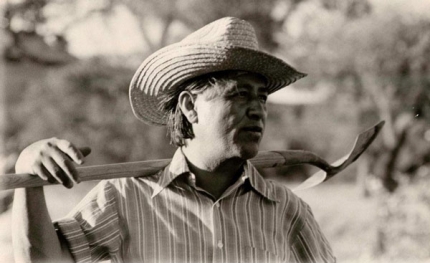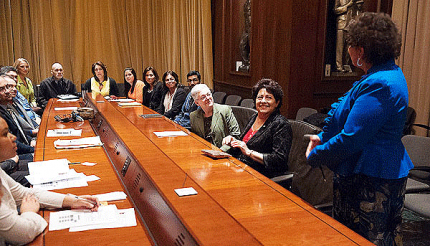Latest News
Nowruz: Welcoming a New Day and the Coming of Spring
Posted by on March 31, 2014 at 10:21 AM EDTAs the President stated in his Nowruz message earlier this month, this holiday is a chance to give gratitude for and reflect on your blessings. “I want to extend my best wishes on this new spring and New Year. As always, this holiday is a chance to give gratitude for your blessings and to reflect on our hopes for the year ahead,” said the President.
Nowruz means “new day” and celebrates the beginning of spring. It represents a time meant for renewal and rejuvenation in preparation for another year. More than 300 million people celebrate this day worldwide.
Recently, the White House Office of Public Engagement was pleased to host its first Nowruz celebration at the White House. We hosted the celebration with guests that represented the many different ethnicities and faiths who celebrate Nowruz across the U.S. and across the world, including Iranians, Afghans, Tajiks, Uzbeks, Iraqis, Azeris and others. Guests included White House and government staffers, local and exchange students, lawyers, business leaders and academic and community leaders.
From traditional dancers to musicians and poetry, to the haft-seen table and Persian food, guests enjoyed a taste of the New Year at the White House Eisenhower Executive Office Building. Event attendees also took part in an East Wing tour and a policy briefing.
Many White House staffers joined the festivities, including Senior Advisor to the President Valerie Jarrett, who delivered remarks. This celebration brought together individuals of various backgrounds as we welcomed spring together.
To a new beginning, a healthy life and prosperous year ahead!
Rumana Ahmed leads Arab American and Muslim American outreach and is the Executive Assistant to the Director of the Office of Public Engagement.
Learn more aboutChampions of Change Channel Chavez's Life of Service
Posted by on March 28, 2014 at 2:01 PM EDTChampions of Change Channel Chavez's Life of Service
The idea of combining service and leadership is one that defined the life of Cesar Chavez. He dedicated his life to bringing attention to the poverty of migrant farmworkers and other segments of the population that were marginalized or overlooked. Chavez also showed us that, no matter how humble our beginnings, we can all accomplish great things.
With firsthand knowledge of the life of migrant farmworkers, Chavez wanted to ensure that those working in the fields were treated fairly, and were able to strive for better lives for themselves and their children despite their circumstances. Chavez’s leadership helped families secure a safe place to live, get fair wages for their work, and have the opportunity to obtain an education.
As leaders of national service and civic participation across America, we value the themes from Chavez’s life story that inspire the work many of national service family members every day.
During Cesar Chavez Day on March 31, the White House will recognize a group of Americans who are building on his legacy of service as Champions of Change. Two members of our national service family are among those being honored.
AmeriCorps alum Germain Castellanos took lessons he learned with the Illinois’ Youth Conservation Corps to leave behind a past that was caught up in gang-related violence and drug use to become a mentor to youth headed down a similar path. He now leads the SHINE program in his community to guide at-risk students from high school to college, and received a governor’s award for his work in 2008.
Xavier Muñoz, an AmeriCorps member serving with the Literacy Council of Northern Virginia, teaches English to immigrant families in his community, opening doors to citizenship and improved opportunities. Muñoz, the son of naturalized parents, has a B.A. in Biology from Stanford University and his work with AmeriCorps has inspired him to continue to teach and work toward his Master’s degree.
These are just two of the many examples of how our national service members and programs are fulfilling Chavez’s legacy, as well as the promise of President Obama’s My Brother’s Keeper initiative, by making sure that all Americans have opportunity chance to succeed and benefit from all this nation has to offer. Chavez Day truly offers an opportunity to honor that legacy as a national moment of service and volunteering.
It is a mission that we believe Chavez would endorse. He once said, "We cannot seek achievement for ourselves and forget about progress and prosperity for our community ... Our ambitions must be broad enough to include the aspirations and needs of others, for their sakes and for our own.”
AmeriCorps members like Germain and Xavier are living up to these ideals.
Wendy Spencer is CEO of the Corporation for National and Community Service and co-chair of the Task Force on Expanding National Service. Jonathan Greenblatt is Special Assistant to the President and Director of the Office of Social Innovation and Civic Participation in the Domestic Policy Council.
The White House Cesar E. Chavez Champions of Change event will be moderated by Lisa Garcia Quiroz, CNCS Board Chair and Chief Diversity Officer & Senior Vice President of Corporate Responsibility at Time Warner Inc., and will be live streamed at www.whitehouse.gov/live at 10AM ET on March 31.
Learn more aboutWomen Leading the Way
Posted by on March 28, 2014 at 9:46 AM EDTRecently, EPA hosted a group of students and professors from the University of Puerto Rico’s Graduate School of Public Health. The group was visiting EPA and other agencies in Washington, DC to explore internship and employment opportunities in the federal government. It was exciting to see this group of young well-prepared Latinas ready to join the workforce.
The visiting students and professors met with several Hispanic employees from different EPA program offices. They discussed the work they are currently doing to protect the environment and human health. The employees shared some valuable advice on the skills necessary to be successful in the workplace. Furthermore, they described how they joined the agency. While we had Hispanic scientists, engineers, and lawyers with different areas of expertise, they shared some common experiences. Many had joined the agency through EPA’s internship programs.
The highlight of the afternoon was when Administrator Gina McCarthy and OPM Director Katherine Archuleta met with the visiting group and the employees. Administrator McCarthy emphasized that public health is at the core of EPA’s mission. While describing the work the agency is doing to address health disparities among Hispanics and other minorities, she mentioned the research EPA is conducting on the high incidence of asthma among Puerto Ricans.
During the meeting, Administrator McCarthy stressed the need to have a high-performing workforce that “looked like America” to fulfill the agency’s mission. She encouraged the visiting students to keep their eyes open for future opportunities at the agency. Director Archuleta echoed her words and urged students to visit OPM’s website for internship and job opportunities throughout the federal government. She recommended that they start by registering in USAJOBS. As they left, I overheard several students saying “I’m going to USAJOBS tonight!”
Personally, I was happy to see many women in leadership positions at the agency as well as a new generation of young Latinas following in our footsteps. In sum, the future is bright for women at EPA.
About the author: Lina Younes has been working for EPA since 2002 and currently serves the Multilingual Communications Liaison for EPA. She manages EPA’s social media efforts in Spanish. Prior to joining EPA, she was the Washington bureau chief for two Puerto Rican newspapers and she has worked for several government agencies.
Learn more aboutUSDA Continues Reaching Indian Country Through the Food Distribution Program on Indian Reservations (FDPIR)
Posted by on March 26, 2014 at 5:52 PM EDTEd. note: This is cross-posted from the U.S. Department of Agriculture.Finding groceries can be difficult in many inner city neighborhoods, and in many rural areas the challenge can be even more daunting. Americans living in remote areas might easily spend half a day just making a grocery run. And for many Native Americans living on Indian reservations, simply getting to a place to purchase nutritious foods becomes a constant struggle.Food security is a top priority for Agriculture Secretary Tom Vilsack. “Expanding access to nutritious food will not only empower American families to serve healthy meals to their children, but it will also help expand the demand for agricultural products.”One program expanding access to nutritious foods is the Food Distribution Program on Indian Reservations (FDPIR). FDPIR was first authorized under the Food Stamp Act of 1977 to provide access to nutritious foods to low-income Native American households. FDPIR is administered locally by either Indian tribal organizations (ITOs) or an agency of a state government. Currently, there are about 276 tribes receiving benefits under FDPIR, with an average of 82,600 participants each month.Because FDPIR is administered directly on Indian reservations, it can eliminate the need for recipients to travel great distances simply to acquire nutritious foods. Eligible participants are able to choose from over 70 food options that can be used to create meals that align with the Dietary Guidelines for Americans and MyPlate. In Fiscal Year 2009, the Healthy Eating Index (HEI), which rates diets based on overall nutrition, rated the FDPIR food option package at 85.3 (an HEI score above an 80 is considered a healthy diet).To assist in the preparation of healthy meals using FDPIR foods, FNS recently worked with tribal members to create a recipe book. “A Harvest of Recipes with USDA Foods: The Food Distribution Program on Indian Reservations (FDPIR)” provides creative, regional recipes using FDPIR food options. Each recipe features sensible levels of fat, sodium, and sugar without sacrificing taste. The recipes also list nutrition facts.The FDPIR has made great strides in providing access to nutritious foods and reducing food insecurity on Indian reservations. For more information on FDPIR, visit http://www.fns.usda.gov/programs-and-services.Leslie Wheelock is the Director of Tribal Relations at the U.S. Department of AgricultureLearn more aboutWhite House Champions of Change for Solar Deployment
Posted by on March 26, 2014 at 3:51 PM EDTSince President Obama took office, the United States has deployed over 12 GW of solar power—enough solar to power 1.4 million homes—with half of that in the residential, commercial, and industrial sectors. Solar energy is the most abundant energy resource on earth—173,000 terawatts of solar energy strike the Earth continuously, which equals more than 10,000 times the world's total energy use.
As the President highlighted in his State of the Union address, the pace of solar deployment has picked up. Last year, every four minutes, another American home or business went solar. And spurred by the falling price of panels, since 2008, solar installations have multiplied tenfold—prices are down, demand is up.
President Obama is committed to continuing the momentum. In June 2012, the President launched a comprehensive Climate Action Plan to cut carbon pollution and advance the clean energy economy. As part of that effort, the President set a goal to double wind, solar, and geothermal electricity generation by 2020 and to more than triple the onsite renewable energy production in federally assisted residential buildings. We already achieved our goal of doubling output from these renewables during the first term, so achieving this new goal would imply a four-fold increase in power generation from these clean sources in just 11 years.
As the President said, “every panel is pounded into place by a worker whose job can’t be outsourced.” These jobs are being created by “Champions of Change,” local leaders across the country who are taking action to accelerate the deployment of solar in the residential, commercial, and industrial sectors.
As prices continue to fall, solar is increasingly becoming an economical energy choice for consumers; still, the biggest hurdles to deployment remain the soft costs—like financing, permitting, and zoning. The Administration is working hard to drive down these soft costs through efforts like the Energy Department's SunShot Initiative, and we also want to honor the Champions that are leading the charge across the country.
The White House Champions of Change program regularly highlights ordinary Americans from across the country who are doing extraordinary things in their communities to out-innovate, out-educate, and out-build the rest of the world. To celebrate the breadth of individuals who are taking action on solar deployment, we will honor “Champions of Change” to lift up entrepreneurs, innovators, legislators, affordable housing owners, community leaders, and others who are accelerating deployment.
We are asking you to help us identify standout local leaders and businesses by nominating a Champion of Change for Deployment of Solar in the Residential, Commercial, and Industrial Sectors by 5:00 p.m. on Friday, April 4. These champions can include:
-
Community leaders working to bolster solar adoption; including participants in DOE’s “Rooftop Solar Challenge,” through which 22 teams are working to advance deployment;
-
Business leaders promoting solar procurement (building supply chains and smaller organizations that provide information about the benefits of solar);
-
Companies and non-profits training veterans for solar jobs;
-
Multifamily housing owners, home builders/associations and organizers promoting onsite solar generation on our rooftops, and organizations providing innovative financing mechanisms to developers and homeowners;
-
Utility leaders seizing solar energy’s potential by supporting and facilitating solar deployment, including through community solar; and
- Organizations working to help consumers navigate the regulations and paperwork necessary to install solar in their communities.
Click on the link below to submit your nomination (be sure to choose ‘Solar Deployment’ in the “Theme of Service” field of the nomination form).
Nominate a Solar Deployment Champion of Change
We look forward to hosting this event to highlight the great work taking place in communities to advance solar deployment.
Dan Utech is the Special Assistant to the President for Energy and Climate Change, White House Domestic Policy Council.
Learn more about-
Community leaders working to bolster solar adoption; including participants in DOE’s “Rooftop Solar Challenge,” through which 22 teams are working to advance deployment;
Working Together to Bring Healthy Foods to Communities in Need
Posted by on March 26, 2014 at 12:09 PM EDTRecently, representatives from the White House Domestic Policy Council, the U.S. Department of Agriculture, the Department of Health and Human Services, and the Department of the Treasury joined representatives from various community projects from around the country to discuss how to increase healthy food access to communities in need. The event included representatives from the National Sustainable Agriculture Coalition, the Food Research and Action Center, PolicyLink, and the Fair Food Network.
Participants shared their stories of success, and what we can do to encourage more healthy foods in these communities. For example:
- Mary Donnell, the Executive Director of Green City Growers Cooperative, spoke about her urban greenhouse project in downtown Cleveland, Ohio. After its inception in 2012, Green City Growers has become the largest food production greenhouse in a core urban area in the United States. The cooperative manages over three acres of urban space and employs 25 people from the community. It produces over 3 million heads of lettuce annually, which is then distributed to Cleveland’s most distressed neighborhoods. The organization creates jobs in Cleveland while providing nutritious food to food deserts across the city, one of this Administration’s key goals.
- Gray Harris, the director of the Sustainable Agriculture Programs at CEI, shared her organization’s story as a Community Development Financial Institution in rural Maine. As a CDFI, CEI invests in community-based projects contributing to local economies. CEI’s specific expertise is in strengthening the local food supply chain to increase healthy food access across New England. CEI has invested in nearly 300 food system projects, and it maintains a current active $6.2 million loan portfolio for food system investments. These investments help farms in Maine to stay in production, despite recent stressors on farmers.
- One last story that really exemplified President Obama’s commitment to increasing access was presented to the group by Todd Chessmoore, the Superintendent of the Cody-Kilgore School District in Cody, Nebraska. Cody is a town of just 150 people, and for over a decade, its residents, many of whom are lower income or elderly, had to drive over 30 miles to buy groceries. In order to eliminate this food desert, the Cody-Kilgore School District opened its own student-run and operated Circle C grocery store, the town’s only dedicated food retailer.
These stories were just a few we heard during this event, emphasizing the unique and innovative work being done across the country to enhance health and access to food for folks from all walks of life. The Obama Administration has made increasing healthy food access a priority. In partnership with the White House, the Department of the Treasury, HHS, and USDA have been working collaboratively to support innovative strategies to increase healthy food access.
One such strategy is the Health Food Financing Initiative, or HFFI. The recently signed Farm Bill authorizes an HFFI program at USDA, and the President’s most recent budget proposal includes a $13 million request for this work. The initiative will provide financial and technical assistance to eligible fresh, healthy food retailers for the purposes of market planning and promotion efforts as well as infrastructure and operational improvements designed to stimulate demand among low-income consumers for healthy foods and to increase the availability and accessibility of locally and regionally produced foods in underserved areas.
This program will help USDA to continue collaboration with other federal partners to ensure that communities in need have access to fresh, healthy, affordable food. It will expand healthy food access for families on SNAP – some 46.6 million individuals in 2012, the vast majority of whom are children, elderly, or living in households where members were employed in low-wage jobs.
A particular focus for USDA will be the expansion of healthy food options in rural areas, which often lack grocery stores and other retail outlets. HFFI will allow USDA and our partners to support creative strategies to increase access to healthy foods in rural America.
The USDA’s Know Your Farmer, Know Your Food initiative also coordinates work on local food investments, including distribution, which is a key element of increasing healthy food access. The White House Rural Council is making healthy food access in rural communities a priority, as it impacts the future health and economics of rural America.
Doug McKalip is the Senior Policy Advisor for Rural Affairs at the White House Domestic Policy Council.
Learn more about RuralSun Rises on Tribal Energy Future in Nevada
Posted by on March 24, 2014 at 5:27 PM EDTEd. note: This is cross-posted from the U.S. Department of EnergyLast Friday was a momentous day for the Moapa Band of Paiute in Nevada. Joined by executives of First Solar, the Los Angeles Department of Water and Power, and numerous dignitaries, including U.S. Senate Majority Leader Harry Reid, tribal leaders and community members broke ground on the 250-megawatt Moapa Southern Paiute Solar Project on the Moapa Indian Reservation — making it the first utility-scale solar project on tribal land.Set to be fully operational by the end of 2015, the Moapa Southern Paiute Solar project will deliver clean, renewable energy to the City of Los Angeles for 25 years, providing enough energy for more than 93,000 homes. This amount of renewable energy will displace approximately 313,000 metric tons of carbon dioxide annually — the equivalent of taking about 60,000 cars off the road.The solar project won’t just benefit the environment. It is also having a big effect on the Moapa tribe. The project is expected to create 400 construction jobs, many of which are already being filled by qualified tribal members. Other members of the tribe are taking advantage of the project’s training opportunities to contribute to the clean energy economy.It has been a long journey for Moapa’s elected and community leaders — one that I witnessed firsthand — as they found a way to balance the promise of a clean energy future and the community’s pressing energy needs.Moapa tribal leaders were one of the first to meet with us after the Energy Department’s Office of Indian Energy was established. With a clear vision in mind, the Tribe’s leadership requested technical assistance on this utility-scale project as well as smaller-scale solar projects that could offset the tribe’s high energy costs.In addition to the Moapa Southern Paiute Solar Project, we also worked with the Moapa tribal government and the Department of Agriculture on an on-site, off-grid solar project that will provide all the energy needed to power the Tribe’s travel plaza. It has been a collaborative and rewarding effort for both the community and Energy Department, who share a common goal of supporting tribal efforts that show potential for fulfilling the real promise of clean energy development in Indian Country.At the groundbreaking, Moapa Chairwoman Aletha Tom eloquently phrased the challenge the tribe faced as they create economic opportunities while preserving the Moapa land and cultural heritage. “This is an important step in becoming a leader in Indian Country and will help to create a model for other tribes to follow. If our small tribe can accomplish this, then others can also. There are endless opportunities in renewable energy, and tribes across the nation have the available land on which to build them.”Tracey A. LeBeau is the Director of the Office of Indian Energy Policy and Programs at the U.S. Department of Energy
National Tribal Day of Action To #GetCoveredNow
Posted by on March 24, 2014 at 4:32 PM EDTToday is the National Tribal Day of Action for Affordable Care Act Enrollment. Over 65 events are being hosted in tribal communities across the nation and President Obama wants to ensure that every American Indian and Alaska Native has the information they need to take advantage of new health care options available under the health care law.
The new health care law is another way the federal government is honoring its trust responsibility and obligations to Tribes. Ensuring that additional health care options are available for all Native Americans is simply another step in our ongoing efforts to promote well-being and economic prosperity in Indian Country.
Many Native Americans currently use an Indian Health Service (IHS) or tribal health facility and that is not changing. But private health insurance offers new protections. Taking advantage of the new health insurance options provided by the Affordable Care Act can give American Indian and Alaska Native families the peace of mind of knowing they have comprehensive health insurance, even outside of the IHS system.
Many American Indians and Alaska Natives who have signed up for health insurance coverage report that they were surprised at just how affordable it can be to get covered. Many are eligible for assistance to lower or even eliminate their monthly insurance premiums. And, if you’re a member of a federally recognized Tribe and you choose to buy a private health insurance plan through the Health Insurance Marketplace, you may not have to pay any out-of-pocket costs like co-pays or deductibles. Many American Indian and Alaska Native families are also finding that they are now eligible for Medicaid or the Children’s Health Insurance Program. Overall, this can add up to more reliable and more comprehensive health care at little to no cost.
Today, you can visit a tribal health care enrollment event from Oklahoma to Alaska. Step into the Alaska Native Medical Center for an event hosted by the Alaska Native Tribal Health Consortium or visit Rapid City Regional Hospital where the Great Plains Tribal Chairman’s Health Board staff can walk you through the enrollment process. Across the country tribal communities and urban Indian organizations are partnering to help American Indians and Alaska Natives get covered.
But you need to act to ensure that you and your family fully benefit from the new health care law. Every American Indian and Alaska Native should learn more about how the Affordable Care Act can benefit them as soon as possible. The best way to review your options is to go to HealthCare.gov. You can also visit your local IHS or tribal clinic, or you can call 1-800-318-2596.
David Agnew is the White House Director of Intergovernmental Affairs
Learn more about Health Care
- &lsaquo previous
- …
- 37
- 38
- 39
- 40
- 41
- 42
- 43
- 44
- 45
- …
- next &rsaquo








Twitter